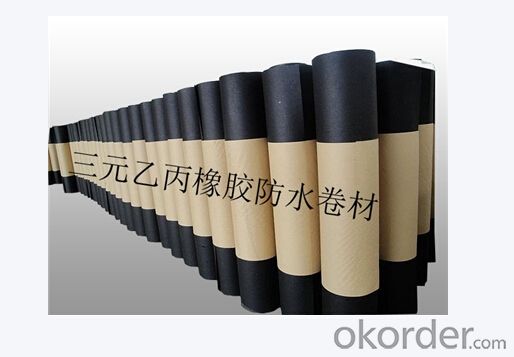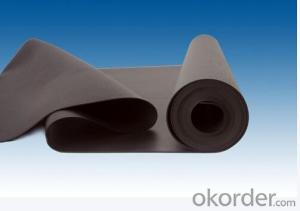EPDM Waterproofing Membrane for Roof Construction
- Loading Port:
- China Main Port
- Payment Terms:
- TT OR LC
- Min Order Qty:
- -
- Supply Capability:
- -
OKorder Service Pledge
OKorder Financial Service
You Might Also Like
EPDM waterproofing Rubber membrane
1. Product Description:
EPDM waterproofing membrane is made from ternary ethylene-propylene rubber. We adopts the world advanced equipment of cold feeding
extrusion and continuous vulcanization technology. With the best performance among high polymer waterproof materials,
EPDM is of exceptional elasticity and will not split or crack under normal building movement.
2. Product Specification:
Type | epdm waterproofing membrane |
Material | EPDM Rubber |
Surface | Fleece back,plain black back |
Thickness | 1.2mm,1.5mm,2.0mm |
Width | 1.2m, 2m-4m, customized |
Length | 20m/roll |
Usage | basements, ponds, Lake, steel structure roofing, underground, tunnels |
Weight(kg/roll) | 1.2mm 37-38 |
1.5mm 40-41 | |
2.0mm 58-59 |
3. Technical Data:
Tensile Strength N/CM | Normal temperature: ≥60 ; 60°C: ≥30 |
Breaking Elongation % | Normal temperature: ≥400; -20°C: ≥10 |
Tear Resistance N | ≥20 |
Impermeability, 30 min no leakage | 0.3Mpa |
Low Temperature Bending °C | ≤ -20 |
Heating Shrinking mm | Extension: ≥2; Shrink: ≥4 |
Heat Resistance (80°C×168h) | Tensile Strength %: ≥80 ; Keeping rate of adhesive breaking:≥70 |
Synthetic aging | Tensile Strength %: ≥80 ; Keeping rate of adhesive breaking:≥80 |
4. Product Application:
Widely used in roofs, basement, toilet, swimming pool, and all kinds of industry and civil building waterproofing, reservoir, vivicism, bridge, underground, tunnel and dam waterproofing, especially to the keystone waterproofing projects which is durability, high corrosion resistance and easy deformation.

4. Some photos:


- Q:Can waterproofing membranes be used on stormwater management systems?
- Indeed, stormwater management systems can benefit from the application of waterproofing membranes. These membranes are frequently utilized to safeguard structures against water infiltration and potential water-related harm. In the case of stormwater management systems, which are designed to collect, retain, and efficiently handle rainwater runoff, waterproofing membranes can be employed to establish a completely watertight seal, thereby averting leaks and seepage. Stormwater management systems often incorporate various components, such as retention ponds, infiltration basins, or underground storage systems. These elements must be adequately sealed to ensure the proper containment and effective management of the collected stormwater. When properly installed, waterproofing membranes serve as an impermeable barrier, effectively preventing water from escaping or infiltrating the system. The utilization of waterproofing membranes on stormwater management systems offers numerous advantages. Firstly, it helps to maintain the system's integrity and functionality by preventing leaks or seepage that could compromise its performance. This ensures that the stormwater is efficiently captured and managed, minimizing the risk of flooding or erosion. Furthermore, waterproofing membranes can significantly prolong the lifespan of stormwater management systems by safeguarding them against water damage. Water infiltration can lead to structural degradation, corrosion, or the proliferation of mold and mildew, all of which weaken the system over time. By establishing a waterproof barrier, these membranes contribute to the preservation of the structural integrity of the components, thus increasing their longevity and reducing maintenance requirements. Moreover, the use of waterproofing membranes on stormwater management systems also contributes to environmental sustainability. By effectively containing and managing stormwater runoff, these systems aid in reducing water pollution and enhancing the quality of natural water bodies. Waterproofing membranes play a vital role in preventing stormwater from carrying pollutants, such as chemicals or sediment, into rivers, lakes, or oceans. In conclusion, waterproofing membranes can be effectively utilized on stormwater management systems to establish a watertight seal, prevent leaks, and protect the components from water damage. By providing an impermeable barrier, these membranes help to maintain the system's functionality and integrity, prolong its lifespan, and contribute to environmental sustainability by reducing water pollution.
- Q:Can a waterproofing membrane be used for tunnels?
- Tunnels, being underground structures, often face water infiltration, making it vital to use a waterproofing membrane to prevent water damage and maintain structural integrity. Specially designed waterproofing membranes can be applied to the walls, floors, and ceilings of tunnels, effectively creating a barrier against water penetration. These membranes, commonly made of materials like bitumen, EPDM, PVC, or polyurethane, exhibit high resistance to water and can endure constant exposure to moisture in tunnels. Furthermore, they also offer protection against other potential sources of water ingress, such as groundwater or heavy rainfall. In summary, employing a waterproofing membrane in tunnels is a dependable and efficient approach to uphold a dry and secure environment within the tunnel structure.
- Q:Are waterproofing membranes resistant to corrosion?
- Yes, waterproofing membranes are typically resistant to corrosion. They are specifically designed to withstand exposure to moisture, chemicals, and other potentially corrosive substances, ensuring long-lasting protection against water infiltration and damage.
- Q:Can a waterproofing membrane be used in saunas?
- Indeed, a sauna can utilize a waterproofing membrane. Given that saunas consist of environments abundant in moisture, implementing a waterproofing membrane can effectively avert water damage and shield the underlying structure against moisture infiltration. The membrane functions as a barrier, effectively impeding the permeation of water and mitigating potential complications like mold growth, mildew formation, and rot. The selection of a waterproofing membrane specifically engineered for high-moisture regions, capable of withstanding the intense heat and humidity characteristic of saunas, is of utmost importance. Additionally, proper installation and adherence to manufacturer guidelines are essential to guarantee the efficiency and durability of the waterproofing membrane within a sauna setting.
- Q:Can a waterproofing membrane be used for modular buildings or container homes?
- Yes, a waterproofing membrane can be used for modular buildings or container homes. These structures often have unique challenges when it comes to waterproofing due to their modular construction and potential for water ingress at joints and connections. A waterproofing membrane can effectively seal these areas, preventing leaks and water damage. It can be applied to the exterior walls, roof, and foundation of the structure, providing a durable and long-lasting waterproof barrier. Additionally, a waterproofing membrane can be customized to meet the specific requirements of modular buildings and container homes, ensuring optimal protection against water infiltration.
- Q:Can waterproofing membranes be used on metal surfaces?
- Yes, waterproofing membranes can be used on metal surfaces. Waterproofing membranes are designed to create a barrier that prevents water from penetrating surfaces, regardless of the material. Metal surfaces can be prone to corrosion and water damage, so applying a waterproofing membrane can help protect them from moisture and extend their lifespan. The type of waterproofing membrane used may vary depending on the specific needs and requirements of the metal surface, but there are various options available specifically designed for metal applications. These membranes are typically flexible, durable, and resistant to UV rays and other environmental factors, ensuring long-lasting protection for the metal surfaces.
- Q:Is a waterproofing membrane compatible with different types of roofing materials?
- Indeed, various roofing materials are compatible with a waterproofing membrane. This flexible solution offers versatility, making it suitable for asphalt shingles, metal roofs, concrete roofs, and even flat roofs. Its purpose is to create a barrier against water infiltration, regardless of the roofing material used. It can be directly applied to the roof's surface or used as an underlayment prior to installing the roofing material. This compatibility guarantees the effective use of the waterproofing membrane, safeguarding and prolonging the lifespan of diverse roof types.
- Q:Can a waterproofing membrane be customized or tailored to specific project requirements?
- Yes, a waterproofing membrane can be customized or tailored to specific project requirements. Waterproofing membranes come in various types and materials, such as bituminous, synthetic, or liquid-applied membranes. These membranes can be modified or adjusted to meet the specific needs of a project. Customization can involve factors like the thickness or weight of the membrane, the type of reinforcement used, the method of application, and the specific performance requirements of the project. For example, a high-traffic area may require a thicker or more durable membrane to withstand heavy loads, while a project in a harsh climate may necessitate a membrane with enhanced resistance to UV radiation or extreme temperatures. Furthermore, the membrane can be tailored to different substrates or surfaces, such as concrete, metal, or wood, by using compatible adhesives or primers. This ensures proper bonding and longevity of the waterproofing system. Additionally, some waterproofing membranes offer customizable options for color or appearance, allowing them to blend seamlessly with the overall aesthetic of the project. Overall, the customization of a waterproofing membrane allows it to be specifically designed and engineered to meet the unique requirements of each project, ensuring optimal performance and long-lasting protection against water damage.
- Q:Can a waterproofing membrane be used on storage tanks?
- Yes, a waterproofing membrane can be used on storage tanks to prevent water leakage and protect the tank from corrosion.
- Q:Can a waterproofing membrane be used in areas with high foot traffic or heavy loads?
- A waterproofing membrane is viable for use in areas subjected to heavy foot traffic or substantial loads. These membranes are created to serve as a protective barrier against water infiltration and can withstand different forms of stress, including foot traffic and heavy loads. However, it is imperative to select a waterproofing membrane that is explicitly designed for such circumstances. Multiple membrane options are available, each possessing varying levels of durability and strength. It is of utmost importance to seek guidance from a professional waterproofing expert or manufacturer to ensure that the chosen membrane is suitable for the specific requirements of the high foot traffic or heavy load area. Proper installation and maintenance of the membrane are also crucial for its long-term effectiveness in these conditions.
1. Manufacturer Overview |
|
|---|---|
| Location | |
| Year Established | |
| Annual Output Value | |
| Main Markets | |
| Company Certifications | |
2. Manufacturer Certificates |
|
|---|---|
| a) Certification Name | |
| Range | |
| Reference | |
| Validity Period | |
3. Manufacturer Capability |
|
|---|---|
| a)Trade Capacity | |
| Nearest Port | |
| Export Percentage | |
| No.of Employees in Trade Department | |
| Language Spoken: | |
| b)Factory Information | |
| Factory Size: | |
| No. of Production Lines | |
| Contract Manufacturing | |
| Product Price Range | |
Send your message to us
EPDM Waterproofing Membrane for Roof Construction
- Loading Port:
- China Main Port
- Payment Terms:
- TT OR LC
- Min Order Qty:
- -
- Supply Capability:
- -
OKorder Service Pledge
OKorder Financial Service
Similar products
New products
Hot products
Related keywords




























